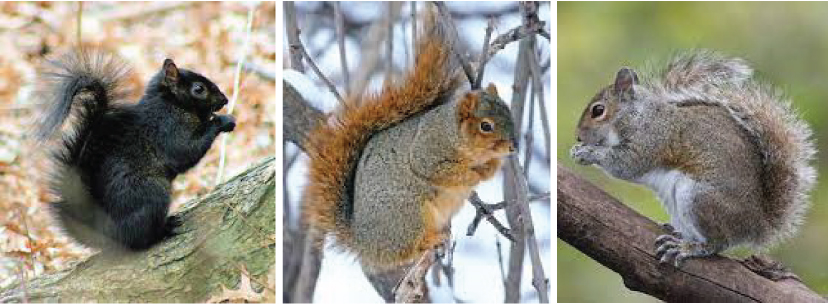SCORES & OUTDOORS: How rare are black squirrels?
 by Roland D. Hallee
by Roland D. Hallee
I know they exist, but just how many are there?
Several years ago I had the rare opportunity to see a black squirrel in Waterville. Last Monday, while driving along the Seaward Mills Road, in Vassalboro, I spotted another one as it was crossing the road in front of me.
In North America, black squirrels are uncommon, with one estimate putting them at a rate of one in every 10,000 squirrels. In 1961, students at Kent State University, in Ohio, released 10 black squirrels that had been captured by Canadian wildlife authorities. The squirrels now populate the campus and have become the school’s unofficial mascot. Their coloring might help them hide from predators, which might come in handy at Kent State: The campus is also home to hawks.
Black squirrels have been spotted in both the United States and the United Kingdom, and now scientists believe they know why. Like many animals with unusual color schemes, black squirrels are the result of a genetic detour. Researchers at Anglia Ruskin University, Cambridge University, and the Virginia Museum of Natural History, collaborated on a project that tested squirrel DNA. Their findings, which were published in BMC Evolutionary Biology, demonstrated that the black squirrel is the product of interspecies breeding between the common grey squirrel and the fox squirrel.
The black squirrel is actually a grey squirrel with a faulty pigment gene carried over from the fox squirrel that turns their fur a darker shade. (Some fox squirrels, which are usually reddish-brown, are also black.)
Scientists theorize a black fox squirrel may have joined in on a mating chase involving grey squirrels and got busy with a female. The black fur may offer benefits in colder regions, with squirrels able to absorb and retain more heat, giving them a slight evolutionary edge.
According to Mental Floss’ Jake Rossen, black squirrels are relatively rare, constituting just one in 10,000 of the seemingly ubiquitous rodents.
Black squirrels are actually grey squirrels with a genetic mutation that causes them to have black fur. They are more aggressive and territorial than the grey squirrels too, and the result is that the black squirrels will usually run all the other squirrels out of an area.
According to this new research, however, black fur actually results from a genetic mutation. This explains why the black squirrel is somewhat rare, making up for an estimated one in every 10,000 squirrels.
Black squirrels are the same species as grey squirrels, with the only difference being their fur color. The new work builds on research from 2014, which found that the black fur is caused by the grey squirrel having a pigment gene with a missing piece of DNA.
In mythical folklore, the black squirrel symbolism does not mean good luck. Instead, it means solar eclipse according to some legends. Therefore, a black squirrel is the enemy of humanity and needs to be destroyed if mankind wants to enjoy the heat and light of the sun. Of course, this doesn’t mean you have to go out and dispatch a black squirrel just because he’s hanging out in your neighborhood.
Black squirrels normally live up to a year, but some have lived up to 10 years. Black squirrels will eat anything they are offered, often feeding on nuts and acorns, any kind of seed, fruit, insects and even bird eggs. Mating occurs from December through January.
WINTER PREDICTION UPDATE
I’m still watching Mother Nature to see what else I can learn from her signs.
I’m still getting mixed messages. I hate to say this, but the majority of signals from nature are that we should prepare for a severe winter. One of the signs is trees, flowers and vegetables. When leaves drop early, autumn and winter will be mild. However, when flowers bloom in autumn, a bad winter is at hand.
Well, the leaves are falling early, but the flowers are blooming late. I have a wild rose bush on the corner of my property, and it has bloomed for the third time this year. Usually, I get one, sometimes two. My neighbor across the street has two large lilac bushes. As everyone knows, lilacs usually bloom around Memorial Day. Well, these two bushes have bloomed for a second time this year. I have never heard of that.
Grey squirrels are also an indicator. I am seeing more and more of them with bushy tails. Another sign of a severe winter.
Again, draw your own conclusion, but I don’t think we are going to get the mild winter repeat from last year.
Roland’s trivia question of the week:
What is the New England Patriots logo commonly referred as?
Responsible journalism is hard work!
It is also expensive!
If you enjoy reading The Town Line and the good news we bring you each week, would you consider a donation to help us continue the work we’re doing?
The Town Line is a 501(c)(3) nonprofit private foundation, and all donations are tax deductible under the Internal Revenue Service code.
To help, please visit our online donation page or mail a check payable to The Town Line, PO Box 89, South China, ME 04358. Your contribution is appreciated!



Leave a Reply
Want to join the discussion?Feel free to contribute!